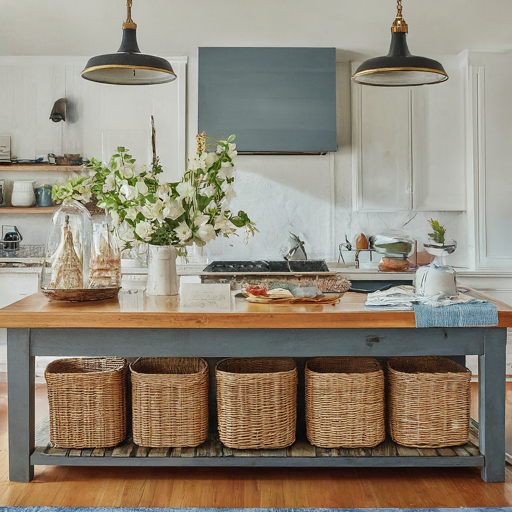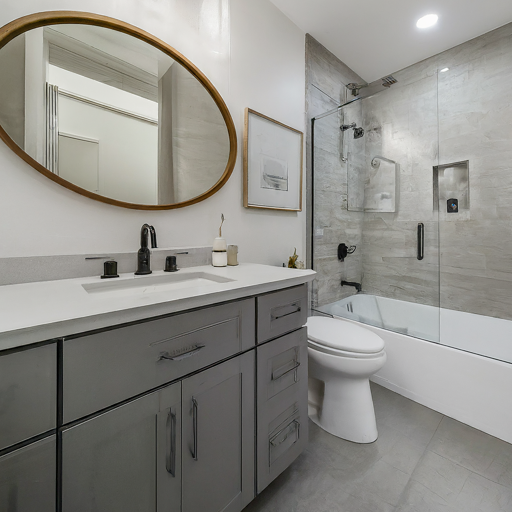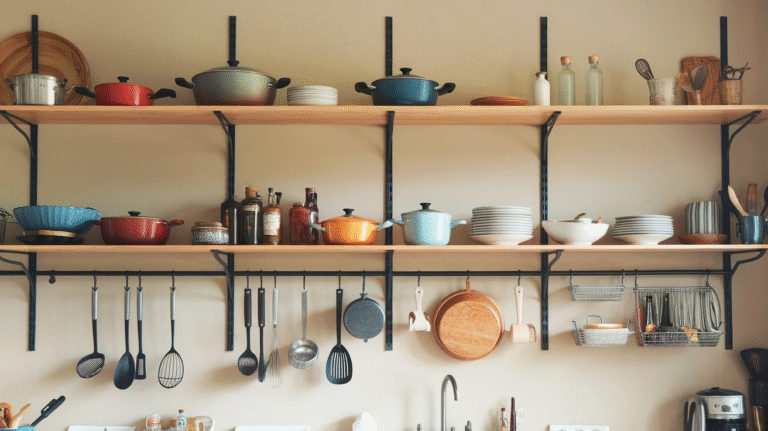23 Small Spaces Home Office Ideas
Working from home sounds dreamy until you find yourself hunched over a laptop on your bed or balancing your mouse on a windowsill.
If you’re nodding in recognition, you’re not alone. Many of us don’t have sprawling rooms to dedicate as home offices, but that doesn’t mean you’re doomed to work in discomfort or chaos.
1. Carve Out a Corner with a Purpose
Not every room needs to scream “office.” Sometimes, it just needs to whisper it. Find a corner in your living room or bedroom and claim it. All you need is a compact desk, a comfy chair, and a bit of lighting. Add a corkboard or floating shelf above, and suddenly, it’s more than a corner—it’s your command center.
2. Transform a Closet into a Cloffice
Yes, that awkward hallway closet can become your productivity hub. Remove the door, add a desk, install a few shelves, and voilà—a “cloffice” (closet + office). This is a fan favorite for a reason: it’s discreet, tidy, and easy to close off at the end of the day.
3. Go Vertical with Shelving
In a small space, think like a squirrel: go upward. Wall-mounted shelves above your desk keep your essentials within reach but off the surface. Use them for books, plants, files, or even small storage baskets. Every vertical inch matters when square footage is tight.
4. Use a Wall-Mounted Fold-Down Desk
This is one of my favorite solutions. A wall-mounted fold-down desk can look like an art panel when closed, and when opened, becomes a full workspace. I installed one in my cousin’s guest room—it doubled as her writing spot and didn’t interfere with guests. Space-saving magic.
5. Float a Desk Behind Your Sofa
The space behind your couch is usually wasted—or at best, home to a dusty console table. Instead, place a narrow desk behind your sofa, facing outward or inward depending on your preference. You can even tuck a stool under it to keep things clean when not in use.
6. Invest in a Corner Desk
Corner desks are geometry’s gift to small homes. They make use of those hard-to-furnish angles while still offering enough room for your laptop, notepad, and coffee. Some even come with vertical shelf units built in. Efficiency at its finest.
7. Sneak into Under-Stair Nooks
That area under the staircase? It’s not just for Harry Potter. With some smart planning, an under-stair nook can become a fully functional workspace. Add lighting, a small desk, and a chair, and suddenly it’s no longer dead space—it’s a productivity portal.
8. Use the Windowsill as a Desk
Don’t overlook the humble windowsill. If it’s wide enough, it can be your minimalist writing desk. Place a small stool in front, decorate with a plant or two, and let the natural light fuel your workflow. Bonus: it’s great for Zoom lighting.
9. Tuck a Desk into Your Hallway
Hallways aren’t just for walking. I once turned a hallway alcove into an editing bay for a friend—a slim desk, adjustable lamp, and a piece of art made it functional and beautiful. Just make sure there’s enough depth to sit comfortably.
10. Opt for a Rolling Cart Office
Sometimes you need to be flexible. A rolling cart with office supplies, a foldable laptop stand, and a wireless keyboard can turn any flat surface—kitchen table, bedside stand—into an instant office. Then roll it away when you’re done. It’s mobility meets productivity.
11. Use a Ladder Desk
Ladder desks lean against the wall, offering a vertical design that blends seamlessly with home decor. They’re ideal for bedrooms, studio apartments, or rental spaces where you can’t install heavy furniture. Think of it as your stealth office setup.
12. Make Use of the Space Behind a Door
The area behind your door can host a fold-down wall desk or even a pegboard system with your supplies. Hang it up, close the door, and it’s practically invisible. It’s one of those “how did I not think of this?” solutions.
13. Convert a Bookshelf into a Workstation
Got a tall bookshelf? Clear a middle shelf and turn it into a seated or standing workspace. Store books above, supplies below, and work right in the middle. I did this in college, and though it was snug, it kept everything organized and accessible.
14. Choose Dual-Purpose Furniture
Furniture that does double duty—a desk that’s also a vanity, a dining table that becomes your meeting hub—makes life in a small space easier. Look for transformer-style desks that fold out, or pieces with hidden storage built in.
15. Hide It in a Cabinet
A secret office? Absolutely. Many people turn armoires or old entertainment centers into compact workstations. Close the cabinet when you’re done, and no one’s the wiser. It’s like working from a wardrobe—without the snow-covered land of Narnia.
16. Float Your Desk with a Window View
Mount a simple plank or narrow tabletop along the bottom of a window frame. Use brackets for support and make sure it’s at desk height. This gives you a bright, airy work zone with built-in nature therapy. Birds, trees, and sunlight—beats cubicle gray any day.
17. Install a Pegboard Organizer Above Your Desk
If your desk surface feels cluttered, go modular with a pegboard. Add cups, small shelves, hooks, and baskets. It keeps things tidy and customizable. I once helped a teacher friend build one, and it ended up being more organized than her classroom.
18. Build a Hidden Pull-Out Desk
If you’re handy or know someone who is, install a pull-out desk drawer into a chest or cabinet. When needed, pull it out and add a chair. When done, slide it back in. This works well in entryways, kitchens, or bedrooms, and it’s as sleek as it gets.
19. Use an Alcove or Recessed Wall Area
Got an awkward recessed space in your room that seems useless? That’s a desk waiting to happen. Install a surface flush with the wall and build up from there with shelves. Paint it a different color for a bold “office nook” vibe.
20. Put a Desk at the Foot of the Bed
If your bed leaves a little space at the foot, slide a small desk there. This works well with minimalist, narrow desks that don’t steal the show. Just keep it clean and styled to match your bedroom decor to avoid visual clutter.
21. Choose a Desk That Doubles as a Nightstand
Your nightstand can moonlight as your desk—no cape needed. Choose a wider bedside table and place a lamp, your notebook, and charging station on it. Slide in a chair when needed. Perfect for laptop users who need a work-and-wind-down combo.
22. Hang a Floating Desk Shelf
Instead of a full desk, install a floating shelf wide and deep enough for your laptop and mouse. Pair it with a stool or slim chair. It’s ideal for short bursts of productivity, quick emails, or journaling. Think of it as your “espresso shot” workstation.
23. Use a Room Divider to Create Zones
Sometimes the problem isn’t space, it’s separation. Add a folding screen, curtain, or bookshelf as a divider to visually and mentally separate your workspace from the rest of the room. Your brain will thank you for the clear boundaries.
Bonus Tips for Maximizing Small Home Office Spaces
Lighting is everything. A well-lit workspace is a productive one. If natural light is scarce, invest in a good LED desk lamp or clip-on light to brighten your space without taking up room.
Cable clutter kills focus. Use cable organizers, zip ties, or even binder clips to keep wires hidden and tangle-free.
Don’t over-decorate. In small spaces, less is more. Stick to a few personal touches—a framed photo, a motivational quote, a plant—and let your desk breathe.
Keep it portable. If you don’t have a permanent setup, create a “go-bag” for work essentials—laptop, charger, notepad, pens—and take it to your favorite work nook each day.
Prioritize ergonomics. Even if your workspace is tiny, make sure it’s comfortable. Use a laptop stand, an external keyboard, or even a cushion on your chair to maintain good posture.
Final Thoughts
Your home office doesn’t need to be big—it just needs to work smart. In fact, some of the best work gets done in small spaces, where distractions are limited and every inch is curated for focus. I’ve seen people build empires from kitchen counters and launch careers from bedroom corners.
Whether you’re designing a permanent nook or a pop-up desk in your living room, the trick is to embrace the challenge. Small spaces aren’t a limitation—they’re an invitation to get creative.




